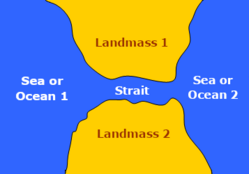Tidal strait
Appearance

A tidal strait is a strait connecting two oceans or seas through which a tidal current flows. Tidal currents are usually unidirectional but sometimes are bidirectional. Tidal straits, though they are narrow seaways, are technically not rivers. They are frequently of tectonic origin. In them, currents develop because of elevation differences between the water basins at both ends.[1]
Tides sometimes allow sediments to collect in tidal straits.[2][3]

See also
[edit]References
[edit]- ^ Longhitano, Sergio G.; Mellere, Donatella; Steel, Ronald J.; Ainsworth, R. Bruce (April 9, 2012). "Tidal depositional systems in the rock record: A review and new insights" (PDF). basin.earth.ncu.edu.tw. Retrieved 27 May 2019.
{{cite web}}: CS1 maint: multiple names: authors list (link) - ^ Longhitano, Sergio; Steel, Ronald J. (June 2015). "Deltas sourcing tidal straits: observations from some field case studies". Retrieved 27 May 2019.
{{cite web}}: CS1 maint: multiple names: authors list (link) - ^ Rossia, V.M.; Longhitano, S.G.; Mellere, D.; Dalrymple, R.W.; Steela, R.J.; Chiarellae, D.; Olariua, C. (November 2017). "Interplay of tidal and fluvial processes in an early Pleistocene, delta-fed, strait margin (Calabria, Southern Italy)". Marine and Petroleum Geology. 87: 14–30. doi:10.1016/j.marpetgeo.2017.02.021. Retrieved 27 May 2019.
{{cite journal}}: CS1 maint: multiple names: authors list (link)
